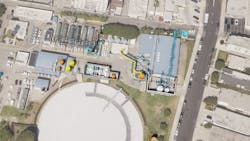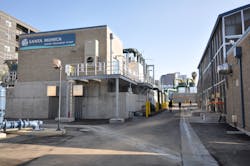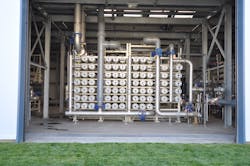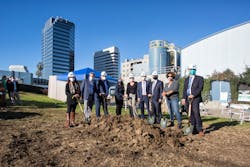To enhance the sustainability of its local water supply, the City of Santa Monica, Calif., has focused its efforts on developing alternative water supplies and expanding local groundwater resources. In January 2022, city officials broke ground on a project to expand the Arcadia Water Treatment Plant and to restore the Olympic Well Field. These projects are a $72 million undertaking with the potential to restore up to 3,200 acre-feet per year of water, according to city leaders.
But the project is just one piece of a larger plan for the city — which imports about 30 to 40 percent of the water it uses — to become water self-sufficient by 2030. City leaders hope to accomplish this goal by combining infrastructure improvements with efficiency programs, demand reduction, and the addition of local water supplies. In all, the total effort will cost around $200 million.
Planning for Self-Sufficiency
In 2011, Santa Monica’s city council directed the Department of Public Works’ Water Resources Division to develop a water self-sufficiency plan. In 2015, that plan was updated in light of major drought conditions and new drinking water regulations. The city would ultimately adopt its Sustainable Water Master Plan in 2018.
“The key guiding principles for the sustainable water master plan are to provide long-term cost benefits to our ratepayers; to have a diverse, sustainable, and drought resilient water supply; to support a sustainable community; and to reduce the energy footprint over water infrastructure to support the overarching goal for the city to be carbon neutral,” says Sunny Wang, water resources manager for the City of Santa Monica.
Any city in California could see the benefits of water self-sufficiency. Between 2014 and 2017, the percentage of the state dealing with exceptional drought ranged from 20 percent to a peak of nearly 60 percent, according to the United States Drought Monitor. As recently as 2021, the state’s level of exceptional drought hit nearly 50 percent.
But even before that, Santa Monica was dealt a blow in 1996, when its Charnock Sub-Basin public drinking water supply wells were shut down due to contamination from the gasoline additive MTBE. According to a 2005 press release from the Environmental Protection Agency, the well provided more than six million gallons per day of local water.
Wang estimates that the well accounted for nearly 75 percent of the city’s groundwater supply, and shutting it down forced the city to import about 80 percent of its water at the time. According to the EPA release, 12 oil companies responsible for the pollution were expected to pay more than $200 million to address the contamination.
“So, city leaders realize how important having a diversified water supply is,” Wang says.
So, how does Santa Monica define water self-sufficiency? That would be about 90 percent local water supply, Wang says. Currently, local water accounts for only 50 percent of the area’s total water portfolio.
Wang says the plans initially called for an even higher percentage of local water, but those goals were adjusted when the results of a housing needs assessment compelled officials to add 9,000 housing units to their estimates.
Upgrading the Arcadia Water Plant
One of the biggest pieces of the self-sufficiency solution is the Arcadia Water Plant, a brackish water desalination facility.
“It’s a three-stage reverse osmosis (RO) system that’s primarily [designed] to reduce the hardness in our groundwater, but it also acts as a second treatment barrier as part of our multi-barrier treatment train for the contaminants we have in the groundwater,” Wang says.
Due to treatment requirements necessitated by the Charnock well’s contamination, the system has a recovery rate of about 80 percent: for every 10 gallons of water coming into the plant, eight gallons become drinking water while two gallons become a concentrated brine. The brine is currently discharged to the City of Santa Monica sewer system. The drinking water from the Arcadia Water Treatment Plant goes straight into the city’s distribution system for potable use.
The project to improve the facility’s recovery rates will be produced using a design-build method, to be delivered in collaboration with Walsh Construction and Brown & Caldwell.
“The progressive design-build approach allowed for greater overall collaboration between the city, Brown & Caldwell (designer), and Walsh Construction (contractor),” says Shaun Jameson, project manager for Walsh Construction. “This collaboration enabled the team to vet two high-recovery RO processes through pilot testing, provided for greater operation involvement in the design, and enabled the city to identify additional treatment plant changes that could be incorporated into the project through the guaranteed maximum price (GMP) development process.”
To achieve 90 percent recovery, leaders looked at two solutions: closed-circuit RO and a flow reversal RO system. Ultimately, flow reversal RO technology was chosen because it can operate in a high recovery rate for the longest time with minimal cleaning and membrane replacement costs.
“The flow reversal technology is designed to increase the recovery of a reverse osmosis system by periodically reversing flow through the RO membranes to limit the formation of scale and precipitants from concentrated minerals in the feed stream onto the surface of the RO membranes,” says Adam Zacheis, a senior project manager for Brown & Caldwell. “Scale formation decreases system RO performance, through higher energy use and reduced water productions, which leads to more frequent membrane cleaning.”
Restoring the Olympic Well Field
Another major component for Santa Monica’s plan is the restoration of its Olympic Well Field.
This site currently operates at only 30 percent due to contamination from solvents used at a nearby airport during World War II. City leaders plan to build a new treatment facility, co-located at the Arcadia plant, which will use an ultraviolet advanced oxidation (UV-AOP) system designed to achieve one of the highest contaminant removal efficiencies in the country (nearly 99.9 percent removal of 1,4-Dioxane). In combination with UV treatment during the UV-AOP process, hydrogen peroxide storage further breaks down any residual contamination in the groundwater before further treatment at the Arcadia Water Treatment Plant.
This project will restore the well to its full production capacity, creating 3,200 acre-feet per year of local groundwater.
Harvesting Urban Stormwater
Santa Monica also follows a Sustainable Water Infrastructure Plan (SWIP), in which the city plans to treat municipal wastewater, stormwater, and urban runoff to produce advanced treated recycled water for non-potable reuse as well as potable reuse to inject the water into the Olympic Well Field. A major component of that plan is the 0.5 MGD Santa Monica Urban Runoff Recycling Facility (SMURRF), a first-of-its-kind water recycling plant that treats dry weather urban runoff by conventional and advanced treatment systems to remove pollutants such as sediment, oil, grease, and pathogens for beneficial non-potable use, such as irrigation.
Also part of the plan is a recently completed 1.5-million-gallon stormwater harvesting tank, which captures drainage near the Santa Monica Pier. Water from this tank will be treated at the SMURRF.
“We’re just advancing mother nature’s cycle through advanced treatment technologies to be able to leverage that water more quickly and within our region,” Wang says. “So, we’re able to control our own destiny a little better by having a locally-sourced water supply.”
To fund these initiatives, the City of Santa Monica has issued rate increases, which Wang says will double over the next five years. However, he pointed out that Santa Monica would still be under priced when compared to its neighbors like Los Angeles or Beverly Hills.
Wang added that the price for imported water from the Metropolitan Water District of Southern California has historically increased at a higher clip than the rate increases for the City of Santa Monica.
In addition to rate increases, a mix of local, state and federal funds are being employed to facilitate The City’s long-term sustainability goals. These include:
- A $75 million loan executed in 2017 from California’s Clean Water SRF for the city’s SWIP.
- $10 million from the California Department of Water Resources’ Water Desalination grant program for improvements to the Arcadia plant.
- $8.77 million from the California Water Resources Control Board earmarked for Santa Monica’s stormwater tank.
- $7.5 million for stormwater capture and treatment components of the SWIP from Los Angeles County’s Safe, Clean Water Program.
- $19.6 million over 25 years for the city’s SWIP and the enhancements to the Arcadia plant. This money comes from the Metropolitan Water District of Southern California’s Local Resources Program. Though the district is the main source of Santa Monica’s imported water, Wang says the group invests in water independence for the areas it serves.
Santa Monica also initiated a $75 million water bond to help bridge funding gaps that arose due to COVID 19. And much of the Olympic Well Field restoration project will be paid for via money from a settlement with the oil companies responsible for the contamination.
Additionally, Santa Monica has also instituted several conservation policies that have helped slow water demand in its service area.
Among them is a water neutrality ordinance, which stipulates that any new development replacing an existing one can’t use more water than the previous development. Wang says the city also plans to invest in smart water meters, a project which is being sent out for bids later this year.
“That’s one of the things our ratepayers really want — is smart water meters to be able to gauge how much water they’re using on a day-to-day basis — and you could actually monitor it down to per-hour [use],” Wang says. “Having this local control and local source supply can help us control our own destiny.” WW
About the Author: Daniel Gaddy is content specialist for WaterWorld magazine. With a bachelor’s and master’s degree in journalism from the University of Alabama, Gaddy spent 10 years as a reporter and editor for community newspapers in Alabama before joining WaterWorld’s parent company, Endeavor Business Media.
Published in WaterWorld Magazine, April 2022.






